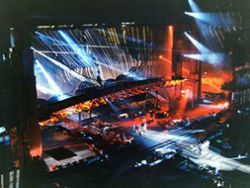
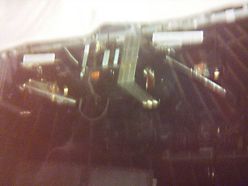

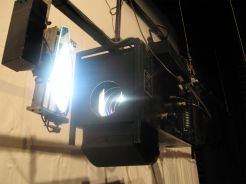
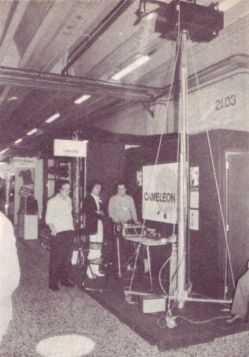
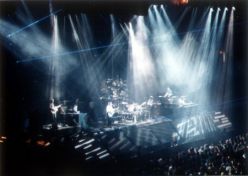
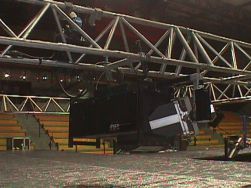

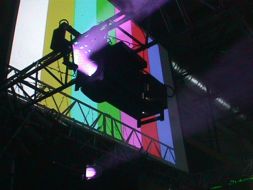

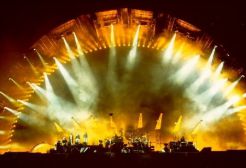

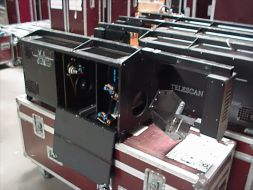
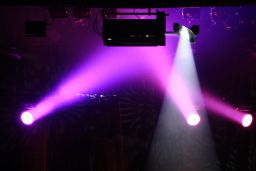
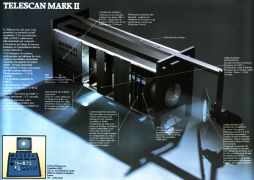
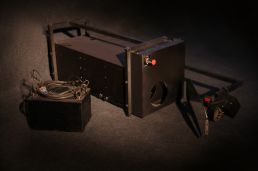
The beginning of everything.
The operating principle of TELESCAN, designed by Didier Leclercq, lighting tech, is used in the 70's with some of his handcrafted pieces for the needs of some shows, often from profile projectors Levron kind on which will be placed remotely mirrors.
He will then undertake more elaborate design of his machines, with his friend Patrice ANDRIEUX, within the CAMELEON company, with the partnership REGISCENE in 1978.
In the early 80s, french singer Daniel Balavoine will greatly help develop the Telescan he plans to use his shows at the Palais des Sports de Paris and the tour that followed. It will then make a large financial contribution to the construction of the first Téléscans.
The Mark-1 Telescan projector is presented in 1981 its almost final version. Although these machines may seem a bit rudimentary today, they encounter some success as extremely innovative for its time, and are found on many prestigious concerts.
Encouraged by this success, the Cameleon team will then develop and build new machines and few generations of Telescans, ever more technically advanced, over the years, and soon to be acclaimed by the lighting designers of the biggest French and international tours.
The Mark-2 TELESCAN will be operational in 85 but built in number from 1986. It is the first projector to be equipped with a system of subtractive CMY color mixing for infinite color from the Cyan, Magenta and Yellow.
36 units of Mark-2 Téléscan has used on the international Pink Floyd tour from 1987 to 1988 with lighting designer Marc BRICKMAN.
The Mark-2 will often be modified based on continuous improvement that developed the Cameleon team to meet the needs of lighting designers.
In 1989, the Mark-2 is the first projector equipped with rotating gobos. The rotating barrel system was developed by Cameleon following an idea of Alain LONCHAMPT, lighting designer for the french singer Michel Jonasz, who wanted to see the image of the gobo rotate on itself.
It was also in 1989 that the Mark-2 will be modified to accommodate a mirror turret whose deflection angle Pan / Tilt (which was previously 90 ° x 90 °) could now reach 180 ° x 90 °.
An agreement is made with the American company Obies, following the growing international demand for a fleet of US-based equipment may be available. The Mark-2 will be available on prestigious tours, like Madonna, Michael Bolton, Janet Jackson, Bob Dylan, Tom Petty, Whitney Houston, etc ...
From 1991, a new model of Telescan projectors is operational. This is the Mark-3 model. It is a more compact version of the mighty Mark-2 model, and it have a dichroic glass CMY color system, a motorized focus and indexable gobos positioning.
A version of these projectors is built with a very special device called "Le voyage dans l'image" (Travel in the image) for projecting images of larger sizes glass film that could circulate in the projector beam . They were then modified for Mark-3 standard model.
In 1994 , the new Mark-4 Telescan arrives for the Pink Floyd 1994 "Division Bell" tour whose film "PULSE" shows among other things, the beautiful light made with 36 of these machines.
The Mark-4 model is a projector using a HMI 2500 W lamp and has no gobo wheel but scrolling images film.
The first series named " Floyd" will also be used , among other things, the Jean- Michel Jarre show at the Eiffel Tower , and Johnny Hallyday's 95 concerts .
Shortly after, the Mark-5 wer built. These projectors, built in very small serie, such as Mark-4, show most of the characteristics of these, but with two image scrolling instead of one, and the possibility of a wide-angle lens for wide. projections Mark-5 is the ultimate model of the series.
Alongside Téléscans, Cameleon has also developed Téléspot, a Fresnel projector with high-power and color changer mounted on automated yoke, and also different projectors giant images, and a 2500 HMI moving head with image scrolling.
Collection & mémoire
Telescan History

